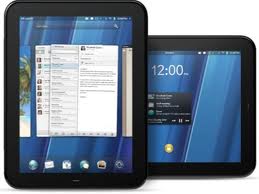

Jim's Android Tablet Review
(Updated: Thursday January 16, 2014)
On January 13, 2014 I gave this presentation on Android tablets to the Computer Club of the Sandhills (Whispering Pines, NC). Android tablets are ubiquitous, available from, not counting electronics and office supply retailers like Best Buy and Staples, but also cellular providers like Verizon, online merchants like Amazon, general purpose retailers like Walmart, even Big Lots! They are available in a bewildering variety of sizes, configurations, and prices, with significantly more issues to be investigated than a traditional Windows desktop or laptop (where there are really only 5 major issues: screen size, CPU, RAM, HD, brand).
I have been using an Android phone (ZTE Warp) and several HP Touchpads (bought during HP's firesale in 2011) for two and a half years. I did a review of the HP Touchpad (Oct. 2011/updated Feb. 2012) - a lifetime ago in terms of electronic technology.
I acquired a first generation Nexus 7 in August 2012. I have bought, experimented with and returned a number of Android tablets, the most notable of which is the Hisense Sero Pro 7 (which is the device I used, borrowed from a friend, for my presentation).
As background, this review presents the basics of the Android OS, and its major versions. The main body of the presentation are the features to be considered when deliberating on the purchase of an Android tablet.
- What is Android? (from Wikipedia article on Android)
- The user interface of Android is based on direct manipulation, using touch inputs that loosely correspond to real-world actions, like swiping, tapping, pinching and reverse pinching to manipulate on-screen objects. Internal hardware such as accelerometers, gyroscopes and proximity sensors are used by some applications to respond to additional user actions, for example adjusting the screen from portrait to landscape depending on how the device is oriented. Android allows users to customize their home screens with shortcuts to applications and widgets, which allow users to display live content, such as emails and weather information, directly on the home screen. Applications can further send notifications to the user to inform them of relevant information, such as new emails and text messages.
- The user interface of Android is based on direct manipulation, using touch inputs that loosely correspond to real-world actions, like swiping, tapping, pinching and reverse pinching to manipulate on-screen objects.
- Internal hardware such as accelerometers, gyroscopes and proximity sensors are used by some applications to respond to additional user actions, for example adjusting the screen from portrait to landscape depending on how the device is oriented.
- Android allows users to customize their home screens with shortcuts to applications and widgets, which allow users to display live content, such as emails and weather information, directly on the home screen. Applications can further send notifications to the user to inform them of relevant information, such as new emails and text messages.
- Android is popular with technology companies who require a ready-made, low-cost, customizable and lightweight operating system for high tech devices. Despite being primarily designed for phones and tablets, it also has been used in televisions, games consoles, digital cameras and other electronics. Android's open nature has encouraged a large community of developers and enthusiasts to use the open-source code as a foundation for community-driven projects, which add new features for advanced users or bring Android to devices which were officially released running other operating systems. [The HP Touchpad which was released in July 2011 with WebOS as its official OS, had a working version of Android by Oct. 2011 developed by the Cyanogenmod hacker community. Development is ongoing - KitKat test builds now available.] If you are willing to experiment you can even put Android on PCs.
"Android is an operating system based on the Linux kernel, and designed primarily for touchscreen mobile devices such as smartphones and tablet computers. Initially developed by Android, Inc., which Google backed financially and later bought in 2005, Android was unveiled in 2007.
- Android key terms (compared to Windows)
- Android "Apps" =~ Windows "Applications/Programs"
- Android "Home Screen" =~ Windows "Desktop"
- Android "Launcher" =~ Windows "Explorer"
- Android "six dots" =~ Windows "Start/Programs"
- Android "Settings" =~ Windows "Control Panel"
- Android gestures have few old Windows Desktop equivalents
- Android "Touch" =~ Windows "Left Click"
- Android "Swipe" =~ Windows "Scroll"
- Android versions commonly encountered today
- 2.3 - 2.7 Gingerbread (now only found on older devices)
- 4.0 - Ice Cream Sandwich (common on older low-end devices)
- 4.1 - 4.3 Jelly Bean (most commonly found on newer devices)
- 4.4 - KitKat (latest and greatest, currently only available on Google Nexus and associated devices).
- For a complete version history consult Wikipedia.
- Aside from these different versions (leading to what is called operating system fragmentation), many manufacturers modify the Android UI (commonly called a "skin") and/or add customized apps to their hardware (i.e., Samsung Note devices designed to use a stylus). There are also issues of companies, most importantly Amazon, who take Android, which is Open Source, and creating their own version of Android called Fire OS for their newer tablets.
- In my admittedly limited experience using Android 2.3 my phone and using all other versions except the limited release 3.0 Honeycomb the different versions did not imply software incompatibility, at least anymore than different Windows versions meant incompatibility from Windows XP to Windows 8. More of a problem in regard to app compatibility is the hardware and not only issues of lack of a hardware feature (you can't use a GPS app without a GPS sensor).
Versions of Android are numbered from 1.0 to 4.4 and code named after desserts:
- Hardware features of Android Tablets
- Screen size, resolution, viewing angles
- Processor: single, dual, quad core
- RAM: 512m, 1g, 2g - as always more is better, but 1g is generally regarded as a minimum for using newer versions of Android (4.0 and up).
- Flash memory: 4g, 8g, 16g, 32g, 64g - not an issue if the device has a memory expansion slot (microSD). Like Apple and Amazon devices, Google Nexus devices do not have these slots.
- Expansion memory: microSD
- Major Brands: Google Nexus, Samsung, Amazon Kindle Fire, Asus, Acer, Lenovo, etc.
- Headphones, speaker jack - mini-RCA out
- Microphone
- HDMI out (for connecting HDTV, monitors)
- WiFi (all have this, but some feature N as well as G protocols, and some have dual band)
- Bluetooth (for connecting wireless headphones, speakers, etc.)
- G-sensor, also called accelerometer (for auto-rotation and some games)
- GPS for navigation
- IR (infrared for TV remote control)
- Videos on the use of Android Tablets and other devices
- Android Beginners Guide (8 minute Youtube video)
- How To Use Android 4 Tablets (10 minute Youtube video)
- 50 Nexus 7 Android Hints and Tips (1 hour Youtube video) (most of the tips apply to other Android devices)
- Chromecast vs the Tronsmart T1000 wireless display adapter (includes 10 minute Youtube video)
- Resource sites for Android
- The Complete Android Guide for Everyone (free 25 page PDF/Epub book)
- 40 Best Free Android Apps
- Androidcentral Forums
- "25 Awesome Google Android Websites You Should Follow"
- Android Task Killers Explained: What They Do and Why You Shouldn't Use Them
- How to Stream Amazon Instant Video on Android Tablets
- Deals on Android Tablets and other devices
- Best Android Tablet Deals & Others (Dealnews page)
- Tablets / eReaders Coupons and Deals (Ben's Bargains page)
- A few of my favorite Apps for Android
- 1Weather:Widget Forecast Radar
- ES File Explorer
- Dolphin Browser
- Moon+ Reader
- Bible
- Wifi Analyzer
- My Tracks
- TuneIn Radio
- TeamViewer for Remote Control
- IVONA Text-to-Speech HQ
- Quickoffice
- Amazon App Store
Not necessarily the apps I use most often, which are Gmail, Calendar, Google Drive, Chrome Browser, YouTube.